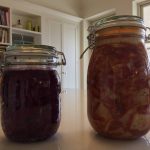KIMCHI – DELICIOUS AND GOOD FOR YOU!
I LOVE Kimchi. I make it regularly and eat some almost every day. I also make sauerkraut and have been lately trying out other vegetables to ferment (more on this next time). 
The fermentation process encourages essential bacteria such as Lactobacilli to flourish in foods such as Kimchi. These probiotic strains are very important to the health of your digestive system. Probiotics detox, digest fibre, produce B vitamins, and help balance the microbes in your gut. Probiotics from fermented foods can help establish and maintain diversity in the bacteria in your digestive system – helping to encourage the “good” guys and discourage the “bad” guys!!!
As the major ingredients of kimchi are chinese cabbage (cruciferous vegetables – great for your liver detoxification process) and other healthy foods such as garlic, ginger, tumeric and chilli powder, it really is a forkful of goodness!!!
Here is how I make my Kimchi ! It is a Day 1 and Day 2 process, but it is very easy!!
- 2 Chinese Cabbages cut into 1/4s lengthways and then into chunks
- 8 tablespoons of sea salt (I use Maldon or Himalayan Salt)
- 1 bunch spring onions – cut into lengths of about 1 inch
- 4 tablespoons of Korean Chilli Powder
- 4 tablespoons of fish sauce (you can use miso paste if vegan, but I have not done this yet so would have to experiment for amount to use)
- 1 large knob of fresh ginger scrubbed or peeled
- 10 garlic cloves peeled
- 1 knob of fresh tumeric scrubbed or peeled (use gloves when preparing as it will stain your hands and your clothes if you get it on them)
- 1 tablespoon of black peppercorns
Day 1: Wash the cabbage and place it in a large plastic bowl and sprinkle over the sea salt. Cover with filtered water until the cabbage is submerged, cover with a plate and weigh it down with something heavy. I leave the cabbage like this until the next day.
Day 2: Strain all the water off the cabbage and rinse it under cold running water. Squeeze out as much water as possible and leave to drain whilst you prepare the rest of the ingredients.
Roughly chop the ginger, garlic, tumeric and place in a Nutribullet with the fish sauce and chilli powder. Blitz until it is a paste (you might need to add a little bit of filtered water to get it paste like).
Put the cabbage back into a large plastic bowl, add the chopped spring onions and the black peppercorns and add the paste from the Nutribullet. (If you don’t have a Nutribullet you can grate the ginger, garlic and tumeric). Massage the cabbage with the other ingredients until it is well combined.
Put your Kimchi mixture into a sterilised Kilner jar, pressing everything down as you fill the jar. The Kimchi mixture should release juice which covers the mixture. Keep adding to the jar and keep pressing everything down. You need a weight which will fit into your jar to keep the Kimchi mixture under the juice. The weight needs to be putting pressure on the mixture, so the top of the jar should fit snuggly over it. Place the filled jar on a plate somewhere out of sunlight at room temperature. (Even with the lid securely closed, the liquid might bubble out and it will make a mess if you don’t have it sitting on something to catch the liquid).
After 2-3 days you will probably see some bubbles, open the jar to burp it and close it again. Do this every day for 6 days, and then the Kimchi is ready to eat. At this stage put your Kimchi in the fridge, the fridge will stop the fermentation process. 
As with all preserving you need to make sure your jar and the weight you use is sterile. Heat oven to 140C/120C fan. Wash the jars in hot, soapy water, then rinse well. Place the jars on a baking sheet and put them in the oven to dry completely. If using Kilner jars, boil the rubber seals, as dry heat damages them.





